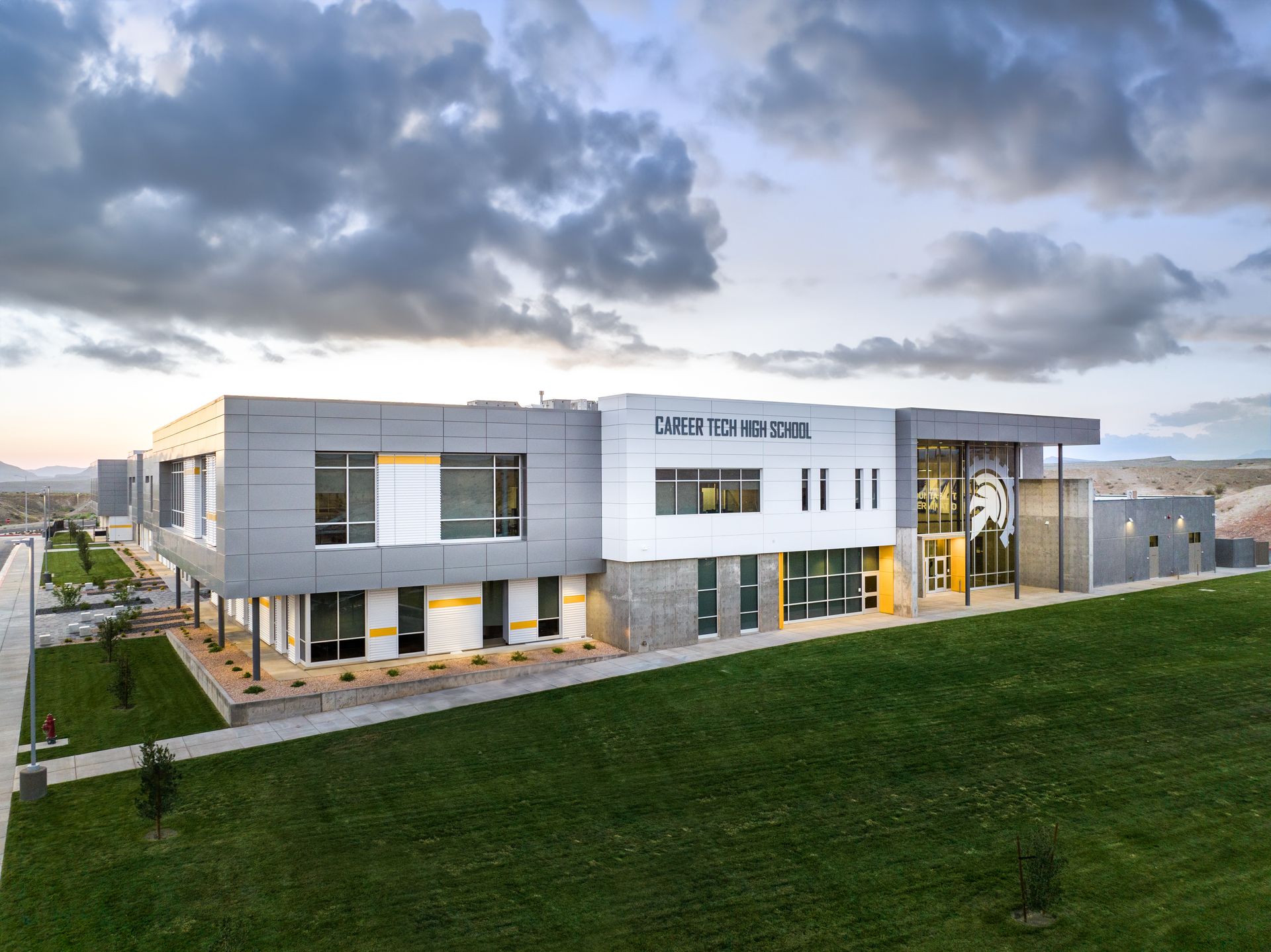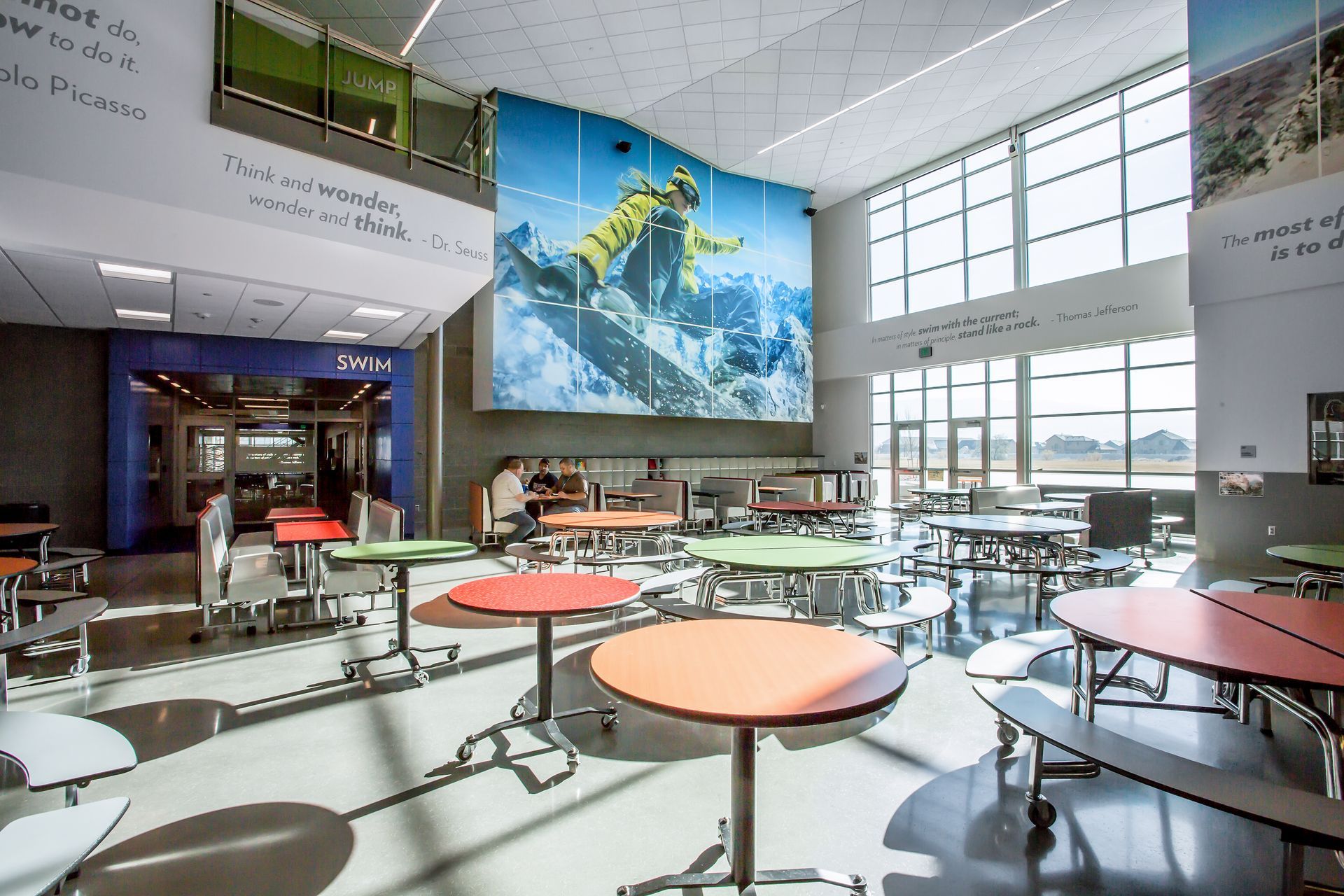
RECENT ARTICLES

It's not every day that an architect designs a project around a native flower, then again, the new Career and Technical Education (CTE) High School in St. George is far from your standard K-12 school. "Essentially, we patterned the floor plan around the Bear Claw Poppy," said Bryan Dyer, Director of Facilities for Washington County School District (WCSD), and one of the primary designers of CTE from 2018-20 while at St. George-based NWL Architects prior to joining the District. "The courtyard is the center of the poppy; the rooms represent flower petals. I think it turned out nice—the courtyard is heavily used and is a unique part of the project. The school board tasked us to do something unique to the District—it's the only building of its kind in the state where students have educational and vocational all in one." "It was kind of a philosophical departure for the District—they recognized the need to pick up the students that fall into a category of not being traditional students—they wanted something different and arrived at the need for a career and technical emphasis," added Terrance White, Principal-in-Charge for NWL. As the first standalone career and technical education facility in Utah, the revolutionary $29.6 million, 126,000 SF school offers eight pathways for the nearly 500 students enrolled at the school (capacity is 800), including: business, construction, culinary arts, engineering, education, graphic design, health science, and information technology. The two-level design prioritizes functionality, creating a dynamic environment where students can explore their chosen fields with purpose and passion. WCSD officials and architects from NWL were inspired by similar CTE schools they toured in Houston and Las Vegas and were able to successfully translate the vision inspired by those schools into a tangible space that fosters true collaboration between students and sets a new standard for a career-focused educational platform. "We toured a school in Houston [...] and recognized the architecture of that building took on more of a junior college feel—it felt like it was something more than a high school but not quite a university," said White. "It's great to see a school district recognize where they can take better care of their students."

It's been more than three decades—1993, to be exact—since the non-profit U.S. Green Building Council (USGBC) was co-founded by S. Richard (Rick) Fedrizzi, David Gottfried, and Michael Italiano, which ultimately spawned the revolutionary Leadership in Energy and Environmental Design (LEED) in 1998, a points-based rating system that offered legitimate third-party verification of green buildings. The goal of the fledgling association was simple: Increase overall sustainability of new construction projects including improved energy efficiency and creating a better, healthier environment for building occupants—all with the goal of reducing construction's carbon footprint. At the time, it was considered a bold initiative, with significant potential real-world benefits to the A/E/C industry. It took several years for the LEED initiative to get off the ground, but by the turn of the 21st Century, the phenomenon started taking root in the design community. "When LEED began in the late 90s/early 2000s, it was an incredible ambition to transform the building industry and to bring sustainability into the conversation," said Whitney Ward, Principal with Salt Lake-based VCBO Architecture and one of the firm's leading sustainable design experts. "[USGBC] had some big hurdles to overcome, including a general lack of knowledge about or mistrust of global warming and climate change." Ward said the U.S. Green Building Council and the LEED rating system had an immediate and profound effect on: —Creating more transparency in material manufacturing and getting manufacturers to care more about developing more sustainable/greener materials (carpet, flooring, paint, textiles, etc.) —Highlighting the true value of sustainable buildings through "incredible marketing efforts" and spurring owner demand. —Becoming the "go-to" third party certification agency for sustainable buildings. "The environmental consciousness of designers, builders, and owners [...] has really evolved to (where we say) 'we're going to do the best we can'," said Ward. "LEED has been an incredible tool in reshaping the industry and helping manufacturers, contractors, architects, and other industry partners understand the impact that their decisions have on the environment and on energy use," said Peter McBride, Principal with Salt Lake-based Architectural Nexus. "The conversation 20-30 years ago used to be 'how much does this cost?' or 'what is the percent increase cost in doing (LEED) vs. the baseline?' As each version of LEED established itself as an industry standard, the answer has been that LEED Certified or LEED Silver costs no more—or slightly more—than a baseline design. With each subsequent version release, LEED continues to push the boundary—sustainable design is now the baseline." "LEED has increased awareness for sustainability and energy conservation in buildings," added Chris Cox, Building Performance Program Manager for the State of Utah Division of Facilities Construction and Management (DFCM). "As far as the biggest pro, LEED brought the integrated design process to the forefront—user groups, owners, maintenance teams, architects, engineers, and builders work together in achieving the best outcomes."

UC+D: How was it working with Gary Payne for so many years? Turner: His impact on the Davis School District will last many years due to the buildings that were constructed during his time. Rather than being satisfied with the status quo, we worked to develop school buildings that would accommodate innovate teaching styles and would be safe, economical, and exciting places where children would want to be. UC+D : It's been 10 years since Odyssey Elementary was completed. What is the analysis of how it has performed? Turner: It is not very hard to create a truly Net-Zero building. We can produce enough electricity to offset the electricity used, plus the natural gas usage—however, the power company will not give us credit for electricity generated above what we use. An energy model was used to estimate the Energy Use Index (EUI) of Odyssey Elementary. It predicted that our EUI would be 22. The first year it was actually 17. An ideal Net-Zero building would not have any natural gas usage. We elected to install a gas boiler in the building to help control the "demand" charges that would occur on cold days when all the heat pumps would start up in the building. For 2023, the PV array produced 213,066 kWh; we used 188,088 kWh in electricity. We used 421 decatherms of gas, giving us a cost of $0.33/sf for energy usage, compared to an average building in the district (about $1.25/sf). UC+D: What is the greatest success with Odyssey? What would you do differently? Turner: Odyssey Elementary, with all its energy-efficient features, provides an excellent educational experience that benefits both teachers and students. The building accommodates different learning styles, collaboration, and individual exploration. First and foremost, the building is a school, albeit one that is very maintainable. There is not anything I would do differently. Since this was the first of a series of prototypes, a lot of thought from a lot of people was put into it.
LATEST ISSUE























